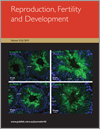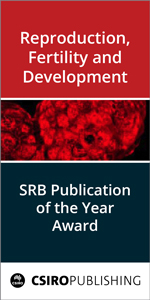Reproduction, Fertility and Development
Volume 31
Number 5 2019
Reproductive biology is core to food supply, offspring developmental trajectories and health throughout life. This review of the 2018 Annual Meeting of the Society for Reproductive Biology summarises the key themes of the conference. Topics include gamete development, pregnancy, the effects of lifestyle on fertility and assisted reproduction.
Cryopreservation is the process of cooling and storing living cells at very low temperatures to maintain their viability after warming. Vitrification is a popular way to freeze ‘ice-free’ human oocytes and embryos. This review discusses how vitrification is being optimised and standardised for in vitro-derived cattle embryos of defined quality as a useful tool for bovine IVF in commercial settings.
DEAD-box helicase 4 (DDX4; also known as vasa) is essential for the proper formation and maintenance of germ cells. After knocking down DDX4expression using retroviral vectors that encoded DDX4-targeting microRNAs, the number of primordial germ cells was decreased in male and female gonads of DDX4-knockdown chicken embryos. This indicates that DDX4 is essential to maintain a normal level of these cells in chicken embryos of both sexes.
The lncRNA Xist is crucial for early development of cloned embryos. However, little is known about Xist in cloned goats. In the present study we investigated the methylation status and expression patterns of Xist in SCNT 8-cell embryos, and well as in ear, lung, and brain tissues of female deceased cloned goats. We found highly methylated Xist in SCNT-generated 8-cell embryos and 3-day-old female deceased cloned goats. The data presented here suggest that highly methylated Xist in SCNT embryos was retained in female deceased cloned goats.
FOXD1 is an important member of the FOX family required for reproduction and development. We identified the male-biased expression of chicken FOXD1 and its location in the testicular Sertoli cell. Furthermore, FOXD1 affects the expression of AMH, SOX9, AR and RIα. These results provide important evidence for the role of FOXD1 during chicken testis development and for reproductive function.
Sperm banking and artificial insemination could benefit conservation of the African wild dog, an endangered species with a dominance hierarchy where subordinates usually do not breed. We investigated the effect of social rank on male reproductive parameters and found no difference in sperm quality between dominant and subordinate males. Thus, reproductive suppression of subordinate males appears to be behaviourally mediated, making males of all social ranks suitable candidates for sperm banking.
Summer heat stress compromises the function of female gametes, reducing the oocyte’s ability to be fertilised and to become an embryo. This study demonstrated the beneficial effect of the ovarian follicular fluid microenvironment in heat-shocked oocytes. Maturation medium supplementation with follicular fluid exosomes prevents heat stress damage in oocytes and can be a key to oocyte protection.
We first report that IQCD is an acrosome-associated gene that is localised in mature spermatozoa and the acrosome area of round and elongating spermatids within seminiferous tubules during the late stage of spermiogenesis. Most importantly, as a Munc13-interacting protein, IQCD plays a role in fertilisation and the acrosome reaction.
For patients with non-obstructive infertility, identifying possible spermatogenesis is important to realise parenthood. The testicular lamina propria is associated with spermatogenesis, and we found that Raman spectroscopy could non-invasively predict spermatogenesis by analysing the tubular lamina propria. The portable Raman system coupled with a fibre optic cable has the potential to be used with microdissection testicular sperm extraction during surgery to select tubules with the potential to develop spermatogenesis.
Atrazine is a widely used herbicide in Australian agriculture and is a common contaminant in drinking water. We found that low concentrations of atrazine in the drinking water had significant effects on the reproductive and metabolic systems of mice. These data have implications for metabolic disorders and infertility in humans and indicate that a reassessment is needed for the levels of atrazine deemed safe in Australian drinking water.
Embryo implantation is a highly synchronised process and a precisely coordinated step during the establishment of pregnancy. Twist2 is found to be involved with embryo implantation and suppression of Twist2 could suppress embryo implantation by regulating EMT. These findings provide clues for understanding the complicated process of embryo implantation and the potential role of Twist2 during embryo implantation.
The use of somatic cell nuclear transfer (SCNT) in equines may result in embryo bisection and twinning, which often lead to abnormal embryo development. A comparative analysis focusing on the central nervous system at 40 and 60 days gestation was performed. Although one fetus, at each age, was smaller in size, there were no macro- or microstructural differences between the twin fetuses, indicating that SCNT does not affect fetal differentiation.
CIRBP is reduced by scrotal hyperthermia, but there is no direct evidence clarifying the relationship between CIRBP and spermatogenesis. This study investigated the effects of the CIRBP on spermatocytes and found that CIRBP protected GC2-spd cells against apoptosis induced by heat stress. These findings suggest that CIRBP exerts a protective effect against spermatogenic injury caused by heat stress.
Male germ cell development requires testis-specific transcripts derived from the use of alternative promoters and transcription factors, and alternative splicing. We discovered that sperm-associated antigen 16S (SPAG16S) and Elongin B, a transcription elongation factor, form a complex localised in nuclear speckles, structures enriched in pre-mRNA splicing factors. This study discloses new players in the generation of germ cell-specific transcripts critical for spermatogenesis.
The Hps1 and Ap3b1 genes encode proteins important to vesicle trafficking, but the roles they played in male reproduction were still unclear. Our results indicate that the Hps1 and Ap3b1 genes play distinct roles in reproductive organ development and spermatogenesis. This study advances our knowledge of protein trafficking on postnatal germ cell development and male fertility regulation.
In mammals, oocyte quality is particularly important to improve reproductive capacity. In this study, baicalin, a traditional Chinese medicine monomer for treating infertility, was used during IVM of pig oocytes. Baicalin improved the IVM of pig oocytes and subsequent preimplantation embryo development by inhibiting apoptosis.
The aim of this study was to explore the mechanism underlying the subfecundity and poor pregnancy outcomes in Why obese obese women who are young, with regular menstrual cycles and without hyperandrogenism. It appears that subfecundity and poor pregnancy outcomes suffer from subfecundity and poor pregnancy outcomes? The aim of the work was to explore its mechanism, which may be associated with high CD36 high expression in granulosa cells. Inhibiting CD36 function of granulosa cells may be one of the method to increase fertility in obese women.
Peripubertal male and female rats maternally exposed to fluoxetine (FLX) were evaluated. The endpoints evaluated were: date of puberty onset, plasma testosterone and oestrogen concentrations before and after puberty onset and corticosterone concentration before and after adrenocorticotrophin stimulus. None of the endpoints were affected by FLX exposure. The results of this study suggest a lack of effect of FLX on steroid-related parameters.
Short periods of ejaculatory abstinence (EA) are used to improve sperm motility in asthenozoospermic subjects, yet the exact mechanism is poorly understood. This study aimed to highlight the effects of accessory sex glands on the composition of seminal plasma after 4 h EA and on sperm motility. We propose that spermatozoa are able to select alternative sources of energy depending on availability.
3-NPA induces granulosa cell apoptosis, follicle atresia and MOFs in the ovaries of female mice, possibly acting through PARP-1 signalling. The aim of this research was to investigate the effects of 3-NPA on ovarian follicular development using both in vivo and in vitro models. These findings will be helpful in investigating the mechanisms controlling follicular development and atresia in mammals.
 , Olivia J. Holland, Brendan J. Houston, Michael W. Pankhurst, Dulama Richani, Angelique H. Riepsamen, Ryan Rose and Michael J. Bertoldo
, Olivia J. Holland, Brendan J. Houston, Michael W. Pankhurst, Dulama Richani, Angelique H. Riepsamen, Ryan Rose and Michael J. Bertoldo 




